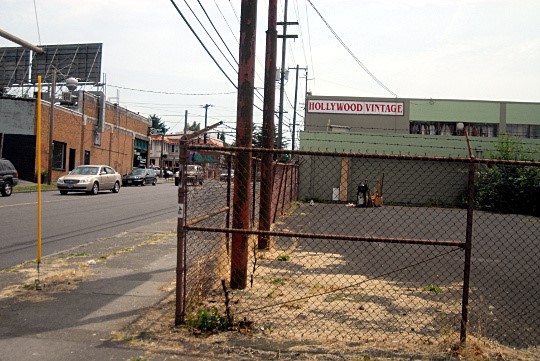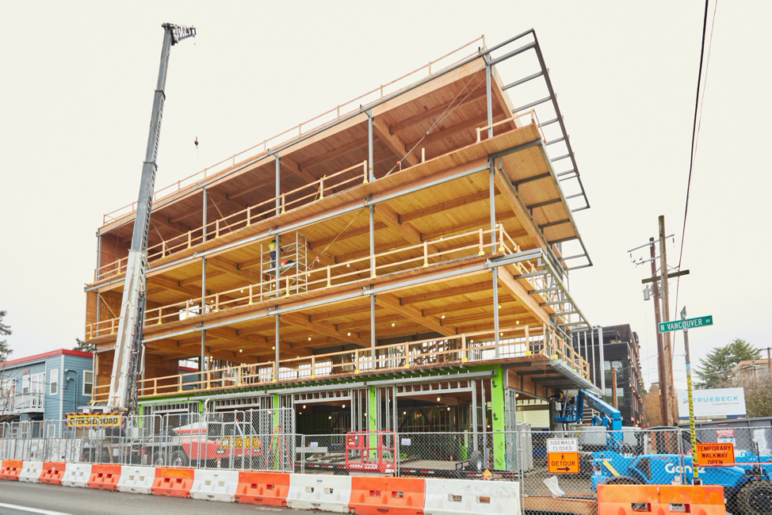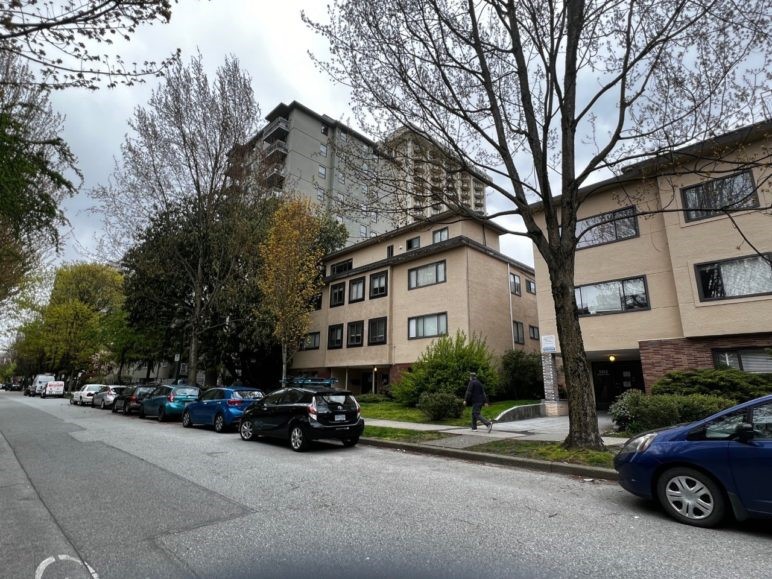This article is part of the series Parking? Lots!
On Thursday, Oregon approved the largest rollback to parking mandates in modern US history.
The unanimous vote by the state’s land use commission came through an unusual channel: an administrative action, ordered by the governor, that breathed new ambition into the broadly written land use laws that have gradually shaped Oregon for 50 years.
The law in question gives the state board the power to set land use rules that, among other things, “minimize adverse social, economic, and environmental impacts and costs.”
As Sightline has been arguing for decades, including in a new series over the last year, parking mandates create those costs. Lots of them.
Beginning January 1, 2023, Oregon is scheduled to do more to cut those costs than any other US state or Canadian province. In some situations—within a half-mile of relatively frequent transit; for homes of 750 square feet or less; for homes meeting affordability targets—minimum parking mandates will no longer apply for jurisdictions within Oregon’s eight largest metro areas. This doesn’t prevent parking lots from being built, but it does remove the current prevailing requirements to construct a specific number of stalls: one stall per bedroom, for example, or three per 1,000 square feet of retail space.
Farther from transit, jurisdictions in the state’s eight largest metro areas will have more flexibility in how to gradually make driving less necessary. In all, 48 cities and 5 counties representing about two-thirds of the state’s population are subject to the reforms. By the end of June 2023, the affected cities and urbanized unincorporated areas will need to choose from a branching menu of options on how to manage parking. In every case, jurisdictions will be able to comply simply by making off-street parking fully optional.
The commission did decide to give the Portland metro area a bit of additional flexibility. Its regional government is allowed to come up with its own parking rules, but the state commission must sign off that they are at worst equivalent to the statewide rules.
After several rounds of delays to the reform timeline, the Land Conservation and Development Commission (LCDC) unanimously voted Thursday for the sooner of two deadlines for putting the new rules in place.
“Science is dictating that we should be acting now,” said Barbara Boyer, an LCDC member and family farmer outside McMinnville, Oregon.
The proposal had drawn support from a coalition of 41 organizations that advocate for affordable housing, the environment, local businesses, and better transportation.
The new parking rules are part of a larger package called “Climate-Friendly and Equitable Communities” that industry groups, including the Oregon Home Builders Association and Oregon Association of Realtors, oppose. Though those groups hadn’t singled out the parking reforms for much criticism, they objected to other parts of the package. Meanwhile, various cities have also objected, arguing that the new rules are too prescriptive and would take considerable resources to implement.
But assuming these new rules survive legal challenge, people looking to build new homes and businesses, or dreaming of renovating an older building, can look forward to deciding for themselves how much parking their property needs. In many cases, it will be the first time since the 1950s that property owners are able to do so.
What will this mean for other Oregonians? Probably not much, for a while. But as the years go by, here are five things they might start to notice.
1. Vacant buildings will come back into use

One of the most visible ways a passerby might notice the elimination of parking mandates is that formerly vacant buildings might quickly get a makeover. Even in small cities like Fayetteville, Arkansas, city leaders are keeping their local economy vibrant by eliminating parking requirements. Keep your eyes on these types of buildings:
- Historic properties: Buildings constructed prior to parking requirements pose a particular problem for redevelopment. There is often no way these buildings can comply with modern parking mandates without a lengthy and expensive process to get an exception from the city. Oregon’s new parking rules bring these buildings back into play.
- Change-of-use properties: What can someone do with an office building left vacant by a pandemic? Maybe not much, if the parking lot is too small. For decades, cities’ zoning codes have defined different parking ratios for nearly every type of business. For example, a retail store might require more parking than an office, and a restaurant more than a retail store. With parking requirements out of the way, business owners who want to adapt will find many more properties available.
2. Businesses will start sharing underused parking lots

How does eliminating parking mandates benefit the numerous half-empty parking lots that already exist? Now freed from parking requirements, owners of these lots can start renting out extra space, creating a virtuous cycle that keeps money in the local economy.
These arrangements are already happening in Ecorse, Michigan, a suburb of Detroit, where parking mandates were eliminated in 2020. Nani Wolf, the planning and zoning administrator for the city, shared a recent example where a developer hoped to renovate a historic building as an event space. There was no parking on-site.
The town did not legally require any parking, but the developer didn’t want to create a nuisance for neighbors. So Wolf helped connect the developer with an adjacent business with a large parking lot the new event-space owners could rent. “That made turning the obsolete building into a functional building possible,” she said.
The cost-sharing helps on multiple levels. First, the new owner doesn’t have to pay to construct new parking, saving them anywhere between $10,000 to $60,000 per space. It also lets neighboring businesses turn unused parking spots into rental income. This new market for parking spaces keeps money local, explained Wolf. Supporting and attracting new businesses is a top priority for Ecorse, which adopted a new zoning code after the town’s top employer, US Steel, announced in late 2019 that its plant would cease operating.
3. Projects will start construction faster

In a city with parking mandates, you’ll be sure to find city planners hunched over their desks calculating how many parking spots each new building proposal requires according to the latest zoning code, then comparing that to the number of spaces in submitted plans. If the proposed building comes up short, there are sure to be follow up meetings with the developer, paperwork for variances, and often appearances before the zoning board or city council. That’s if everything goes smoothly.
“Parking is always the first thing that comes up with people objecting to the project,” said Nick Sauvie, executive director of the Portland-based affordable housing developer ROSE Community Development. When new development is politically contentious, a project might take months or years to win approval from neighborhood groups and public bodies.
A lot of this work can simply disappear once cities decide to get out of the business of inspecting parking lots. This can save time and money for both city staff and developers alike. As Oregon works to double its housing construction over the coming decades to alleviate its severe shortage of homes, reducing delays for things like parking will help.
4. Cities will actually start doing something about crowded curbs

Spending less time micromanaging private parking lots will still leave city planners plenty to do. Now, they’ll be able to focus on a truly public issue: on-street parking.
In most of the United States and Canada, curbside parking is currently a free-for-all. If you can afford to show up alongside almost any street with a $15,000 machine, you’re allowed to occupy that real estate for almost as long as you like, free of charge—no matter if a nearby resident, worker, delivery van, or customer needs it more.
Parking mandates address this problem with the subtlety of a sledgehammer. Annoyed by crowded curbs? No problem, parking mandates say. We’ll just make urbanization illegal.
Oregon’s new rules take away the sledgehammer and instead push into local hands a little box of precision tools: time limits, annual permits, meters, loading zones, disability priority spaces. Different tools will fit different situations. That’s the whole point.
In some crowded places, meters and permits will also raise public money that can be used to improve walking, biking, or transit.
Meanwhile, in less crowded areas, the current free-for-all will continue to work just fine.
Because buildings take a while to build, Oregon cities will have at least a few years before the new rules have any actual effect on curbside parking. In the meantime, hope and expect that cities will start considering their options. The state land use agency says it’s eager to help with both cash and technical information.
“This is where the real work really begins,” state planner Kevin Young told the land use commission Thursday. “We’re not going to be successful if local governments aren’t.”
5. More parking lots will get built
But parking reforms like Oregon’s don’t actually presume that a better world is possible. Their work is deeper. They allow better worlds to be possible.

You read that right.
Despite all this, the Oregon of 2032 will probably have more parking spaces than the Oregon of 2022. The new rules put a few new costs and limits on the size of new lots and garages but mostly just within designated “climate-friendly areas.” And because cars will remain extremely useful, parking spaces will keep getting built whether they’re mandatory or not.
“I applaud the flexibility that this provides to the private sector to provide the parking where it’s most needed,” LCDC Chair Anyeley Hallova said Thursday.
To those of us who dream of quieter, cleaner, greener, freer cities whose public spaces have been fully reclaimed from cars, it can seem inadequate to just make parking optional. Meanwhile, to those of us who would feel imprisoned without cars and enough parking to make them useful, it can be hard to envision a world where cars are truly less necessary.
But parking reforms like Oregon’s don’t actually presume that a better world is possible. Their work is deeper. They allow better worlds to be possible.
To reduce dependence on the car, Oregonians still need to make it pleasant to walk and bike, to fund mass transit, to start neighborhood businesses, and to create homes and jobs near one another. If they can’t, then today’s parking reforms will have little effect one way or another.
Instead, what these reforms do is give Oregonians a better chance to do all those things. They give Oregonians new opportunities to succeed.



Comments are closed.